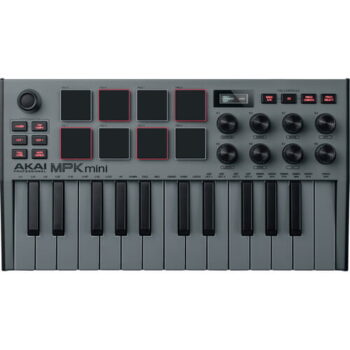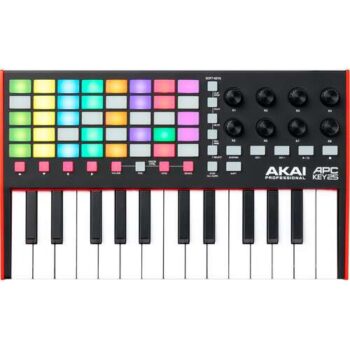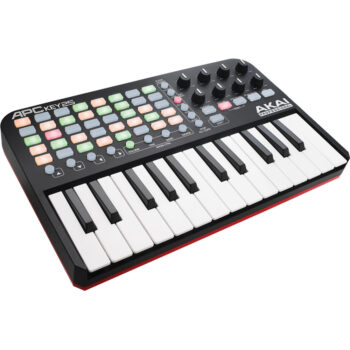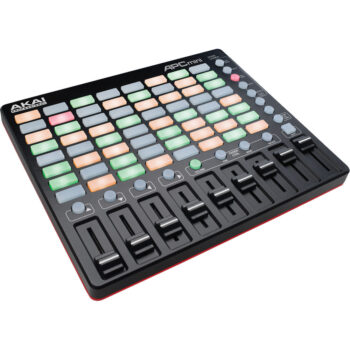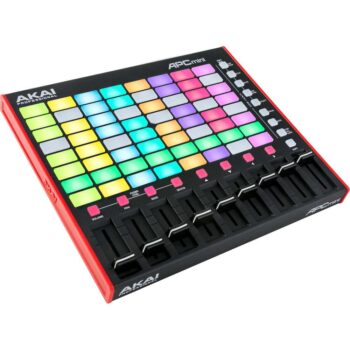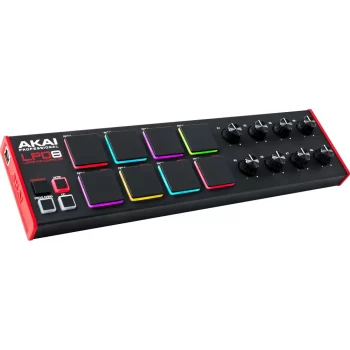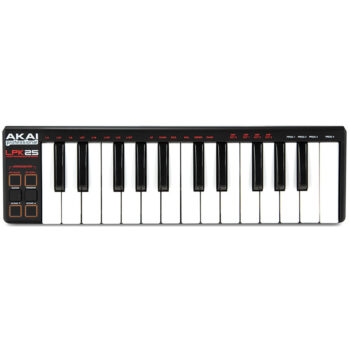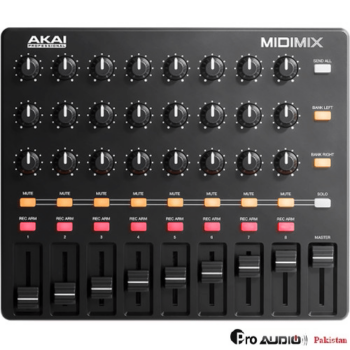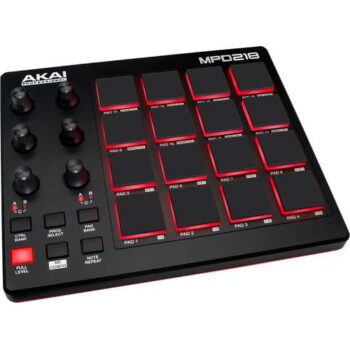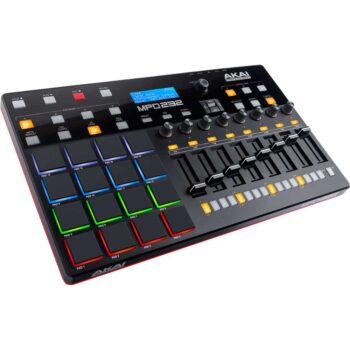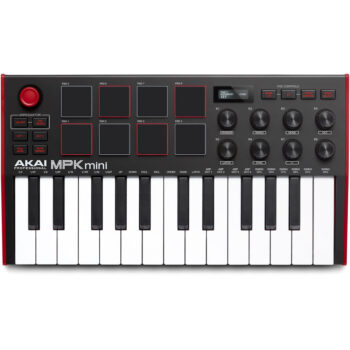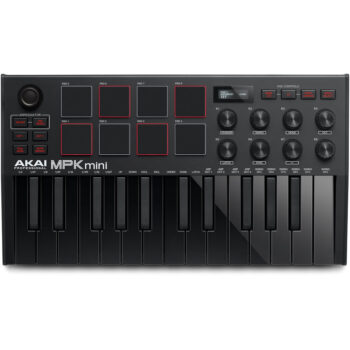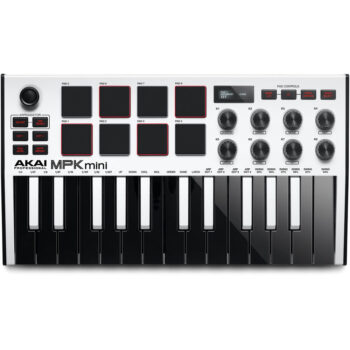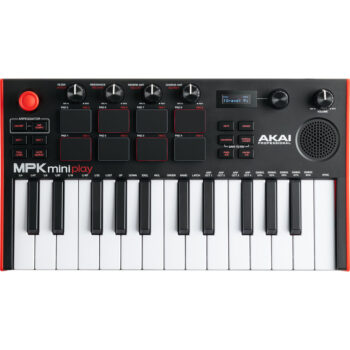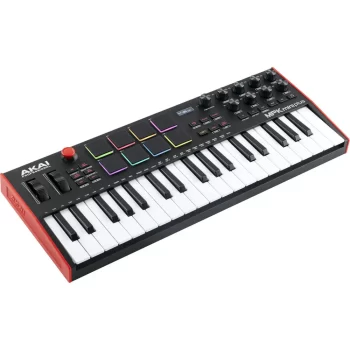In 1984,[8] a new division of the company[9] was formed to focus on the manufacture and sale of electronic instruments, and was called Akai Professional.
S612
The S612 12-bit digital sampler in 1985, was the first in a series of (relatively) affordable samplers already in 19-inch studio-rack format but in black color.[10] It held only a single sample at a time, which was loaded into memory via a separate disk drive utilizing Quick Disk 2.8-inch floppy disks. The maximum sample time at the highest quality sampling rate (32 kHz) was one second.
The introduction of a “professional” range of digital samplers began with the 12-bit S900 in 1986,[10] followed by the X7000 keyboard sampler in 1986,[14] and the S700 rack-mount version in 1987.[10] Unlike the single-sample S612, however, they allowed the use of six active samples at once, had a built-in disk drive and could be extended with six individual outputs via cable and a flash memory extension which added another six samples to the memory for multisample playback. The S700/X7000 sampler series were light-grey colored, which didn’t change throughout the whole “professional” range of Akai samplers.
The 16-bit Akai S1000 series followed in 1988, adding the option to read CD-ROMs and write to hard disks via SCSI. This range was superseded by the S3000 series in 1993, with optional built-in CD-ROM drive, followed by the S5000 and S6000. Additional releases of note were the Z4 and Z8 24-bit 96 kHz samplers.[10]
AKAI PROFESSIONAL
Showing all 17 results
-
USB MIDI Keyboards - Controllers, AKAI Professional, Proaudio
Akai Pro MPK Mini MK3 25-Key MIDI Controller – Grey
USB MIDI Keyboards - Controllers, AKAI Professional, ProaudioAkai Pro MPK Mini MK3 25-Key MIDI Controller – Grey
Key Features- 25 Velocity-Sensitive Keys
- Upgraded Keybed over MK2
- 8 Pads from Flagship MPC
- OLED Display Offers Useful Feedback
- 8 Assignable Q-Link Knobs
- Pitch/Modulation 4-Way Thumbstick
- Arpeggiator
- USB MIDI and Power
- Sustain Pedal Input Jack
- Downloadable Music Creation Software
The ultracompact keyboard controller, the Akai MPK Mini MK3 Grey, is styled with a sleek grey finish and is intended for desktop producers and touring musicians. In several important aspects, it is an improvement over the previous version.
SKU: MPKMINI3G -
USB MIDI Keyboards - Controllers, AKAI Professional, Proaudio
Akai Professional APC Key 25 MK2 Ableton Live Controller With Keyboard
USB MIDI Keyboards - Controllers, AKAI Professional, ProaudioAkai Professional APC Key 25 MK2 Ableton Live Controller With Keyboard
Key Features- Complete Integration with Ableton Live
- 5×8 Clip-Launch Matrix
- 40 RGB Backlit Pads
- 25-Key Gen 2 Dynamic Keybed
- 8 Assignable Endless 360° Rotary Knobs
- Dedicated Scene Launch Buttons
- 4 Directional Buttons to Navigate Matrix
- Includes Ableton Live Lite Software
- macOS/Windows
SKU: APC25MK2 -
USB MIDI Keyboards - Controllers, AKAI Professional, Proaudio
Akai Professional APC Key 25 – Ableton Live Controller with Keyboard
USB MIDI Keyboards - Controllers, AKAI Professional, ProaudioAkai Professional APC Key 25 – Ableton Live Controller with Keyboard
Key Features- Perfect Integration with Ableton Live
- 5 x 8 Clip-Launch Matrix
- 25 Synth-Action Mini Keys
- 8 Assignable Control Knobs
- Downloadable Music Creation Software
- Mac OS X & Windows
SKU: APC KEY 25 -
Drum and Pads, AKAI Professional, Proaudio, USB MIDI Keyboards - Controllers
Akai Professional APC mini Compact Ableton Live Controller
Drum and Pads, AKAI Professional, Proaudio, USB MIDI Keyboards - ControllersAkai Professional APC mini Compact Ableton Live Controller
Key Features- Perfect Integration with Ableton Live
- 8 x 8 Clip-Launch Matrix 9 Faders
- 16 Control + Shift Buttons
- Downloadable Music Creation Software
- USB Bus Powered
- Mac OS X – Windows
Akai Professional APC mini Compact Controller Ableton Live is a portable, all-in-one hardware controller designed to work with Ableton software in a one-to-one integration.
SKU: APC MINI -
Drum and Pads, AKAI Professional, Proaudio
Akai Professional APC Mini MK2
Key Features- Complete Integration with Ableton Live
- 8×8 Clip-Launch Matrix
- 64 RGB Pads
- 9 Assignable Faders
- Smart Scale View Mode
- Dedicated Scene Launch Buttons
- Note and Drum Modes
- 4 Directional Arrows to Navigate Matrix
- macOS/Windows
SKU: APC MINI 2 -
USB MIDI Keyboards - Controllers, AKAI Professional, Proaudio
Akai Professional LPD8 MK2 Laptop Pad Controller
USB MIDI Keyboards - Controllers, AKAI Professional, ProaudioAkai Professional LPD8 MK2 Laptop Pad Controller
Key Features- 8 Velocity-Sensitive RGB MPC Pads
- 8 Assignable Rotary Knobs
- Sturdy, Full-Size USB Port
- Program & CC Control Send Functionality
- Includes MPC Beats Music Prod. Software
- Includes Tons of Drum Samples & Plug-Ins
SKU: LPD8MK2 -
Proaudio, AKAI Professional, Mixers and Recorders
Akai Professional MIDImix High-Performance Portable Mixer and DAW Controller
Proaudio, AKAI Professional, Mixers and RecordersAkai Professional MIDImix High-Performance Portable Mixer and DAW Controller
Key Features- Perfect Integration with Any DAW
- 9 Faders: 8 Channel and 1 Master
- 24 Knobs Total: 3 Per Channel
- 16 Buttons in 2 Banks
- Mute, Solo, Rec Arm Per Channel
- 1 to 1 Mapping with Ableton Live
- USB Bus Powered
- Mac OS X and Windows
- Ableton Live Lite Included
SKU: AMIDImix -
DJ Controller, AKAI Professional, Proaudio, USB MIDI Keyboards - Controllers
Akai Professional MPC Studio Music Production Controller for MPC Software
DJ Controller, AKAI Professional, Proaudio, USB MIDI Keyboards - ControllersAkai Professional MPC Studio Music Production Controller for MPC Software
Key Features- Integrated Hardware/Software System
- Compact Design
- 16 Full-Sized Vel Sensitive RGB Pads
- Color LCD for Browsing and Editing
- Touch Strip Controller
- USB-Powered
- Full Production Suite and DAW
- 128-Track Sequencing
- Over 100 Instruments and Effects
Producers and musicians looking for a complete music production platform based on the legendary MPC workflow will be thrilled with the Akai Professional MPC Studio Music Production Controller for MPC Software, a complete system that combines intuitive hardware control and innovative, inspiring software.
SKU: MPCSTUDIO2 -
-
Drum and Pads, AKAI Professional, Proaudio
Akai Professional MPD226 USB Controller
Key Features- 16 x Thick Fat RGB-Backlit MPC Pads
- 4 x Assignable Faders
- 4 x Assignable Q-Link Knobs
- 4 x Assignable Q-Link Buttons
- 36 x Assignable Controls via Three Banks
- Classic MPC Note Repeat, MPC Swing
- MIDI In & Out Jacks
- Dedicated Transport controls
- Software Package Included
SKU: MPD226 -
Drum and Pads, AKAI Professional, Proaudio
Akai Professional MPD232 USB Controller & Sequencer
Key Features- 64 Channels, 32-Step Sequencer
- 16 x Thick Fat RGB-Backlit MPC Pads
- 8 x Assignable Q-Link Knobs
- 8 x Assignable Q-Link Switches
- 8 x Assignable Faders
- 72 x Assignable Controls via Three Banks
- Classic MPC Note Repeat, MPC Swing
- Dedicated Transport Controls
- MIDI In & Out Jacks
- Software Package Included
SKU: MPD232 -
USB MIDI Keyboards - Controllers, AKAI Professional, Proaudio
Akai Professional MPK Mini MK3
Key Features- 25 Velocity-Sensitive Keys
- 8 Pads from Flagship MPC
- 8 Assignable Q-Link Knobs
- Arpeggiator
- USB MIDI and Power
- Sustain Pedal Input Jack
- OLED Display Offers Useful Feedback
- Pitch/Modulation 4-Way Thumbstick
- Downloadable Music Creation Software
The Akai Professional MPK Mini MKIII is an ultracompact keyboard controller designed for the traveling musician and the desktop producer.
SKU: MPKMINIMK3 -
USB MIDI Keyboards - Controllers, AKAI Professional, Proaudio
Akai Professional MPK Mini MKIII 25-Key MIDI Controller (Black)
USB MIDI Keyboards - Controllers, AKAI Professional, ProaudioAkai Professional MPK Mini MKIII 25-Key MIDI Controller (Black)
Key Features- 25 Velocity-Sensitive Keys
- Upgraded Keybed over MKII
- 8 Pads from Flagship MPC
- OLED Display Offers Useful Feedback
- 8 Assignable Q-Link Knobs
- Pitch/Modulation 4-Way Thumbstick
- Arpeggiator
- USB MIDI and Power
- Sustain Pedal Input Jack
- Downloadable Music Creation Software
Styled in a sleek black finish, the Akai Professional MPK Mini MKIII Black is an ultracompact keyboard controller designed for the traveling musician and the desktop producer. It is an upgrade over the previous iteration in several key ways.
SKU: MPKMini3BK -
USB MIDI Keyboards - Controllers, AKAI Professional, Proaudio
Akai Professional MPK Mini MKIII Limited Edition White
USB MIDI Keyboards - Controllers, AKAI Professional, ProaudioAkai Professional MPK Mini MKIII Limited Edition White
Key Features- 25 Velocity-Sensitive Keys
- Upgraded Keybed over MKII
- 8 Pads from Flagship MPC
- OLED Display Offers Useful Feedback
- 8 Assignable Q-Link Knobs
- Pitch/Modulation 4-Way Thumbstick
- Arpeggiator
- USB MIDI and Power
- Sustain Pedal Input Jack
- Downloadable Music Creation Software
Styled in a sleek white finish, the Akai Professional MPK Mini MKIII white is an ultracompact keyboard controller designed for the traveling musician and the desktop producer. It is an upgrade over the previous iteration in several key ways.
SKU: MPK MINI MK3 (WHITE) -
USB MIDI Keyboards - Controllers, AKAI Professional, Proaudio
Akai Professional MPK Mini Play MK3 25-key MIDI Controller
USB MIDI Keyboards - Controllers, AKAI Professional, ProaudioAkai Professional MPK Mini Play MK3 25-key MIDI Controller
Key Features:- Akai Professional MPK Mini Play 25-key MIDI Keyboard MK3
- Built-In Sound Module with 128 Sounds
- 25 Velocity-Sensitive Keys
- 8 Real MPC Drum Pads
- 4 Knobs for Sound Edit or MIDI Controls
- Built-In Full-Range Speaker
The Akai Professional MPK Mini Play 25-key MIDI Keyboard MK3 sound engine features 128+ onboard drum and keyboard sounds. The controller can be powered by 4 x AA batteries, which provide up to 14 hours of performance
SKU: MPKMINIPLAYMK3 -
USB MIDI Keyboards - Controllers, AKAI Professional, Proaudio
Akai Professional MPK Mini Plus 37-Key MIDI Controller
USB MIDI Keyboards - Controllers, AKAI Professional, ProaudioAkai Professional MPK Mini Plus 37-Key MIDI Controller
Key Features- 37 Velocity-Sensitive Keys
- 8 Pads from Flagship MPC X
- OLED Display Offers Useful Feedback
- 8 Assignable Rotary Knobs
- Pitch/Modulation 4-Way Joystick
- Dedicated Pitch Bend & Modulation Wheels
- Arpeggiator and Step Sequencer
- USB MIDI and Power
- Sustain Pedal Input Jack
- Includes MPC Beats Production Software
Musicians, producers, DJs, and other music creators looking for a compact yet full-featured keyboard controller for studio production and live performance will be impressed with the Akai Professional MPK Mini Plus MIDI Controller 37 Key, a keyboard controller with 37 velocity-sensitive keys, utilizing a next-generation dynamic keybed for great playability
SKU: MPKMINIPLUS


